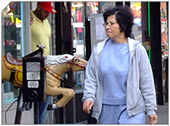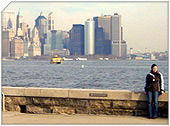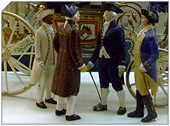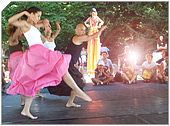Getting Started
Index
NYC Neighborhoods
Manhattan
Brooklyn
Queens
Bronx
Staten Island
NYC Icons
Chrysler Building
Flatiron Building
Empire State Building
Safe NYC
NYPD
FDNY
NYC Weather
NYC Climate
NYC Weather Forecast
Winter Season
Spring Season
Summer Season
Fall Season
NYC History & Politics
New York City History
Tammany Hall and Politics
New York City Politicians
New York City Personalities
Culture of Gotham City
Culture of the city
Cultural diversity
City in popular culture
|
George Gershwin (September 26, 1898 - July 11, 1937) was an American composer. He wrote most of his vocal and theatrical works in collaboration with his elder brother, lyricist Ira Gershwin. George Gershwin composed both for Broadway and for the classical concert hall. He also wrote popular songs with success.
Many of his compositions have been used on television and in numerous films, and many became jazz standards. The jazz singer Ella Fitzgerald recorded many of the Gershwins' songs on her 1959 Gershwin Songbook (arranged by Nelson Riddle). Countless singers and musicians have recorded Gershwin songs, including Bing Crosby, John Coltrane, Frank Sinatra, Billie Holiday, Miles Davis, Herbie Hancock, Judy Garland, Nina Simone, John Fahey, and Sting.
Biography
Gershwin was born Jacob Gershowitz in Brooklyn, New York to Russian Jewish immigrant parents. His father, Morris (Moishe) Gershowitz, changed the family name to Gershwin sometime after emigrating from St. Petersburg, Russia. Gershwin's mother, Rosa Bruskin, also immigrated from Russia; she married Gershowitz four years later.
George Gershwin was the second of four children. He first displayed interest in music at the age of ten, when he was intrigued by what he heard at a friend's violin recital. The sound and the way his friend played captured him. His parents had bought a piano for his older brother Ira, but to his parents' surprise and Ira's relief, it was George who played it. Although his younger sister Frances was the first in the family to make money from her musical talents, she married young and became a housewife, giving up her own singing and dance career-settling into painting, a hobby of George's.
Gershwin tried various piano teachers for two years, and then was introduced to Charles Hambitzer by Jack Miller, the pianist in the Beethoven Symphony Orchestra. Hambitzer acted as George's mentor until Hambitzer's death in 1918. Hambitzer taught George conventional piano technique, introduced him to music of the European classical tradition, and encouraged him to attend orchestra concerts. (At home following such concerts, young George would attempt to reproduce at the piano the music he had heard.) He later studied with classical composer Rubin Goldmark and avant-garde composer-theorist Henry Cowell.
His first job as a performer was as a "song plugger" for Remick's, a publishing company on New York City's Tin Pan Alley. His 1917 novelty rag "Rialto Ripples" was a commercial success, and in 1919 he scored his first big national hit with his song "Swanee." In 1916, he started working for Aeolian Company and Standard Music Rolls in New York, recording and arranging piano rolls. He produced dozens, if not hundreds, of rolls under his own and assumed names. (Pseudonyms attributed to Gershwin include Fred Murtha and Bert Wynn.) He also recorded rolls of his own compositions for the Duo-Art and Welte-Mignon reproducing pianos. As well as recording piano rolls, Gershwin made a brief foray into vaudeville, accompanying both Nora Bayes and Louise Dresser on the piano.
In 1924, George and Ira collaborated on a musical comedy, Lady Be Good which included such future standards as "Fascinating Rhythm" and "The Man I Love."
This was followed by Oh, Kay! (1926); Funny Face in (1927); Strike Up the Band (1927 & 1930); Girl Crazy (1930), which introduced the standard "I Got Rhythm"; and Of Thee I Sing (1931), the first musical comedy to win a Pulitzer Prize. "I Got Rhythm", in particular, became a jazz standard.
In 1924, Gershwin composed his first major classical work, Rhapsody in Blue for orchestra and piano, which was arranged by Ferde Grofé and premiered with Paul Whiteman's concert band in New York. It proved to be his most popular work.
Gershwin stayed in Paris for a short period, where he applied to study composition with Nadia Boulanger. While there, he wrote An American in Paris. This work received mixed reviews. There are orchestral nods towards Ravel's piano concerto of the same period. Eventually he found the music scene in Paris supercilious, and returned to America. Though he hugely admired the French style of music-and did until the day he died-Gershwin remained thoroughly American.
His most ambitious composition was Porgy and Bess (1935). Called by Gershwin himself a "folk opera," the piece premiered in a Broadway theater and is now widely regarded as the most important American opera of the twentieth century. Based on the novel Porgy by DuBose Heyward, the action takes place in a black neighborhood in Charleston, South Carolina, and with the exception of several minor speaking roles, all of the characters are black. The music combines elements of popular music of the day, which was strongly influenced by black music, with techniques found in opera, such as recitative and leit motifs.
Early in 1937, Gershwin began to complain of blinding headaches and a recurring impression that he was smelling burned rubber. He had developed a brain tumor. It was in Hollywood, while working on the score of The Goldwyn Follies, that he collapsed and, on July 11, 1937, died following surgery for the tumor at the age of 38. Ironically, just a few months later in 1937, Gershwin's idol Ravel also died following brain surgery.
Gershwin had a 10-year affair with composer Kay Swift and frequently consulted her about his music. Oh, Kay was named for her. Posthumously, Swift arranged some of his music, transcribed some of his recordings, and collaborated with Ira on several projects. Gershwin also had an affair with actress Paulette Goddard.
Gershwin could be generous, warm, and a good friend, but he could also be vain and more than a trifle egotistical. His friend and champion, the concert pianist Oscar Levant once asked him: "George, if you had it to do all over again, would you still fall in love with yourself?"
Gershwin died intestate, and all his property passed to his mother. He is buried in the Westchester Hills Cemetery in Hastings-on-Hudson, New York. The Gershwin estate continues to bring in significant royalties from licensing the copyrights on Gershwin's work. The estate supported the Sonny Bono Copyright Term Extension Act because its 1923 cutoff date was shortly before Gershwin had begun to create his most popular works. The copyrights on those works expire at the end of 2007 in the European Union and will expire between 2019 and 2027 in the United States of America.
In 2005, The Guardian determined using "estimates of earnings accrued in a composer's lifetime" that George Gershwin was the richest composer of all time.
George Gershwin was inducted into the Long Island Music Hall of Fame in 2006. The George Gershwin Theatre on Broadway is named after him.
|
New York City Search
Quick NYC
|



 New York Weather Forecast
New York Weather Forecast
 Ethnic composition
Ethnic composition


















